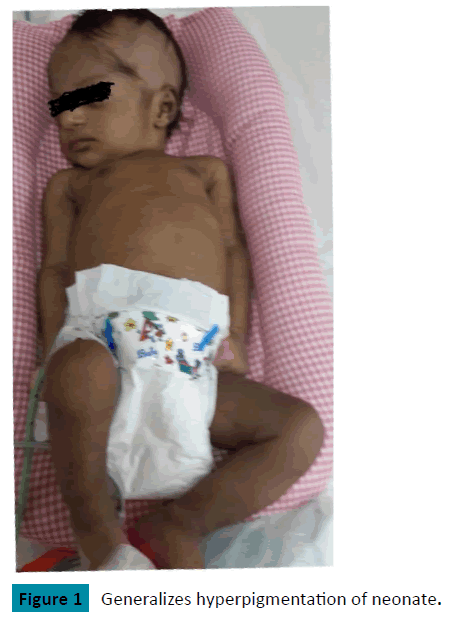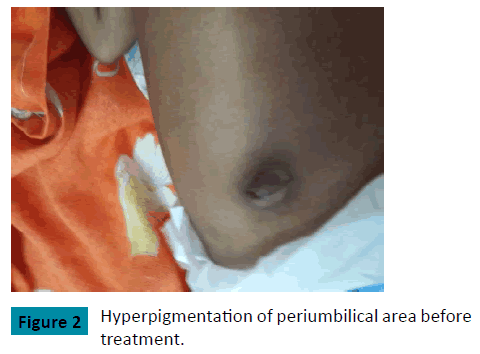Hyperpigmentation in a newborn with familial glucocorticoid deficiency
Roya Farhadi and Daniel Zamanfar
1MD, Neonatologist, Pediatrics Department, Mazandaran University of Medical sciences, Sari, Iran
2MD, Pediatric Endocrinologist, Pediatrics Department, Mazandaran University of Medical sciences, Sari, Iran
- *Corresponding Author:
- Roya Farhadi
assistant professor of neonatology, Department of Pediatrics
Boo- Ali Sina Hospital, Pasdaran Boulevard, Sari, Iran
E-mail: dr.royafarhadi@gmail.com
Tel: +981133343018
Citation: Farhadi R, et al. Hyperpigmentation in a newborn with familial glucocorticoid deficiency. J Rare Dis Diagn Ther. 2015, 1:1. doi:10.21767/2380-7245.10001
Copyright: © 2015 Farhadi R, et al. This is an open-access article distributed under the terms of the Creative Commons Attribution License, which permits unrestricted use, distribution, and reproduction in any medium, provided the original author and source are credited.
Introduction
Patient is a 10 days old female neonate who referred to our center because of darkening of the skin, lethargy and poor feeding. She was born by C-section at 38 weeks of gestation and had history of admission in another maternal hospital due to hypoglycemia and jaundice during first 5 days of life. Birth weight was 2760 gr and height was 50cm. Parents were relative and had a light colored skin. Mother had a history of abortion in previous pregnancy. In physical examination generalized skin and mucosal hyperpigmentation and hypotonia had been observed (Figures 1,2). Genitalia had a normal female appearance but hyperpigmented. Vital signs and blood pressures were normal. Laboratory findings showed low blood glucose (36mg/dl) and cortisol levels (0.5ug/dl), high adrenocorticotropic hormone (ACTH>1000ng/l) and normal aldosterone levels (500pg/ml). level of 17-OH-Progesteron was normal (1ng/ml).Other investigations such as blood gases, serum electrolytes and abdominal ultrasonography were normal. According to the above data, diagnosis of familial glucocorticoid deficiency was made and hydrocortisone treatment at a dose of 10 mg/m2/day was started and continued orally after discharge.
Unfortunately, we couldn’t perform molecular genetics study in our institutions due to lack of facilities. The patient was followed up and after three months of treatment; the hyperpigmentation had lessened in comparison with birth time and his blood sugar and cortisol levels were normalized and she has a good weight gain. Familial glucocorticoid deficiency (FGD) is a rare autosomal recessive disorder in which the adrenal cortex fails to respond to stimulation by ACTH to produce cortisol [1]. This condition leads to Low serum cortisol, markedly increased ACTH and normal aldosterone levels [2].The actual incidence of FGD is unknown and only isolated case reports has been reported [3]. This disorder is caused by mutations in the gene of the ACTH (MC2R gene) receptor [4]. Although FGD is easily treatable by replacement with hydrocortisone, can be easily missed due to its nonspecific presentation .Therefore it may lead to death or severe morbidity [3]. In conclusion early detection of this disease in infants with dark skin is important.
References
- Clark AJ, Weber A (1998) Adrenocorticotropin insensitivity syndromes. Endocr Rev 19: 828-843.
- Chung TT, Chan LF, Metherell LA, Clark AJ (2010) Phenotypic characteristics of familial glucocorticoid deficiency (FGD) type 1 and 2. ClinEndocrinol 72: 589?594.
- Metwalley KA, Farghaly HS (2012) Familial glucocorticoid deficiency presenting withgeneralizedhyperpigmentation in an Egyptian child: a case report.J Med case Rep16: 6:110.
- Ram N, Islam A, Islam N (2012)A case report: Familial glucocorticoid deficiency associated with familial focal segmental glomerulosclerosis.BMC Endocrine Disorders: 12:32.
Open Access Journals
- Aquaculture & Veterinary Science
- Chemistry & Chemical Sciences
- Clinical Sciences
- Engineering
- General Science
- Genetics & Molecular Biology
- Health Care & Nursing
- Immunology & Microbiology
- Materials Science
- Mathematics & Physics
- Medical Sciences
- Neurology & Psychiatry
- Oncology & Cancer Science
- Pharmaceutical Sciences


